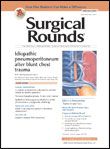Chewing Gum Improves Gut Function After Colorectal Surgery
In 10 randomized controlled studies, patients who chewed gum after elective colorectal surgery had shorter lengths of hospital stay and were less likely to experience complications.

In addition to making hungry patients happier, early postoperative feeding promotes recovery and produces other beneficial effects.
In the past, surgeons ordered nasogastric (NG) tube placement and restricted oral intake until bowel activity was recorded. Today, most enhanced recovery after surgery (ERAS) protocols do not recommend NG tube placement and severe oral restrictions. While clinicians are searching for alternative methods to proactively stimulate the gut, chewing gum might be an inexpensive way to do it.
Researchers from the John Hunter Hospital in Australia conducted a meta-analysis of 10 randomized controlled studies that used “sham feeding” in a combined 62 patients to stimulate the gut after elective colorectal surgery. All of the studies used chewing gum as an intervention, but some used sugar-free gum, while others used gum containing sugar.
The authors found sham feeding reduced time to flatulence by 31 minutes and time to first bowel movement by 30 minutes. Patients treated with sham feeding had shorter lengths of stay, as they were discharged slightly more than a half-day earlier than those who were not.
While patients who chewed gum were also less likely to have complications, the authors could not explain how the intervention reduced the incidence of anastomotic leaks and chest, surgical site, and catheter-related infections. They hypothesized that small improvements in gastrointestinal (GI) function might translate to large overall improvements. Since different gum types were used, it appears the act of chewing gum and swallowing saliva, rather than the gums’ compounds, accounted for the improvements.
The authors pointed out that their work does not prove sham feeding improves outcomes compared to conventional feeding. In institutions that have ERAS programs with early feeding, clinicians should continue to use that protocol, but also keep in mind that sham feeding may enhance gut function recovery in patients who develop clinically significant ileus and cannot swallow food.
